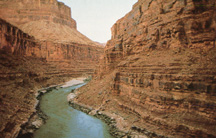Colorado River Vision
Annual Colorado River Water Users Association meeting brings river users together.
LeRoy W. Hooton, Jr.
December 18, 2001
|
Before old issues are resolved, new ones emerge, keeping the seven-basin states’ water watchers on their toes and ready to protect their interests. Over the past several years California’s overuse of its allotment under the 1922 compact has been a dominant issue. Last year, the 4.4 Plan was approved, which required California to wean itself off of the approximately 800,000 acre-feet of water it is using over its allotment. The overuse debate seems to be settled, but there is still murmuring if California can really make it.
The Mexican Delta
The lack of water flowing into the delta is creating environmental damage. On May 18, 2000 a joint declaration was signed by United States Department of Interior and the Secretariat of Environment Natural Resources and Fisheries (SEMARNAP) of the United Mexican States to enhance cooperation in the Colorado River Delta. Advocates for more instream flows want to increase the flow by 32,000 acre-feet annually, periodic floods of 260,000 acre-feet every four years, while also maintaining the 135,000 acre-feet highly-saline waste flow to the Cienega de Santa Clara. This issue affects the compacts, agreements and an international treaty. If more water is needed, most likely it will have to come from the other states’ allocations – something that is not going to be readily accepted by the states north of the border.
Utah Water Resources director, Larry Anderson, did not reject the idea but told the conference attendees that the states needed to be educated on the matter. Others were less polite, one speaker from the audience said that if it were an environmental problem within the United States, the states would have to resolve it with their own water allocation. On September 11-12, United States and Mexican authorities sponsored a symposium in Mexicali, Baja California to discuss the delta; however, Anderson noted that it failed because of the terrorist attacks in the United States. “People were distracted and many had to leave, but I hope that when the scientific papers are published they will provide us the information we need to fully understand the issues,” said Anderson.
The Salton Sea
Another issue weighing on river watchers is the Salton Sea. The largest lake in California is becoming more saline, threatening the fish and bird populations. The lake is now 25 percent saltier than the ocean with a concentration of 44 parts per thousand. Fed by irrigation return flows, the lake is getting saltier because of high evaporation rates experienced in the hot desert climate. Congress passed the Salton Sea Reclamation Act in 1998 directing the Secretary of Interior, acting through the Bureau of Reclamation, to prepare a feasibility study in 2000 on restoring the lake.
Salt evaporation ponds appear to be the most feasible means of removing one million tons of salt annually. Another option is bringing additional water into the lake to dilute the salt concentration. It’s proposed that adjoining farmland go fallow, with the saved irrigation water going towards freshening the lake. According to Salton Sea Authority executive director Tom Kirk, without land management, saving the Salton Sea will be impossible. This means not planting about 20 percent of land around the lake. The option to construct 112-inch pipelines from the Pacific Ocean and Gulf of California to bring water to and from the Salton Sea was rejected as a feasible solution to reducing the lakes salinity.
It’s predicted that if nothing is done to reverse the situation, the lake’s environs will be destroyed in 12-15 years. However, the lake’s demise may be accelerated by a water transfer agreement between the Imperial Irrigation Company and the San Diego County Water Authority amounting to 300,000 acre-feet. Contained in the transfer agreement is language that prohibits fallowing Imperial Irrigation Company farmlands.
A Common Vision
A panel of Colorado River experts remained confident in the future of the river; however, cooperation will be necessary to solve the myriad of problems in managing the river. Las Vegas Valley Water District general manager Patricia Mulroy, told the audience “The basin states needed a common vision for the river,” continuing, “We need to build bridges between farmers and cities, the environmental community and the Indians need to feel their rights are respected.” There was general agreement when it came to litigation and the environment. Panel participants agreed on these two matters as summed up by Mulroy. “We can, outside of court, resolve the issues that face us,” said Mulroy. And regarding the environment, “Environmental issues are here to stay,” said Mulroy. “Environmental stewardship is going to be the responsibility of every water manager.”
It’s no wonder the Colorado River is the centerpiece of the basin states and Mexico. The water development timeline of the Colorado River is short, spanning less than a century and already there is not enough water for everyone’s needs. The environmental consequences of man’s use of the Colorado are becoming ever more clear. On the other hand, the Colorado has created benefits necessary to sustain a growing population in the Colorado Basin. The challenges to balance environmental stewardship and provide water resources into the future will continue to bind the basin states and Mexico together to find that “common vision for the river.”
Links: www.slcclassic.com/utilities/NewsEvents/news121800.htm
www.slcclassic.com/utilities/NewsEvents/news10102000.htm
www.slcclassic.com/utilities/NewsEvents/news2000/news03072000.htm
www.slcclassic.com/utilities/NewsEvents/news1999/news12231999.htm
www.slcclassic.com/utilities/NewsEvents/news1999/news082799.htm
